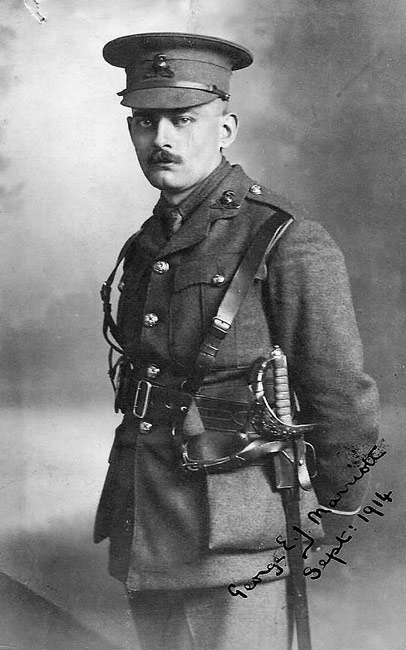Captain, Lancashire Fusiliers, 1st Company of the 6th Battalion (Territorial force)
Killed in Action, 6th July 1917 in France
Buried in Ruyaul Court Military Cemetery, France
Little personal information is to be found on the CWGC page for Captain Marriott but, from information gathered from various sources, we know a little more about him.
He was born on the 2nd May 1888.
It is reasonable beyond doubt that he is the George E.J. Marriott on the 1891 census, age 2, living with his parents, Edward P. Marriott and Mary I. Marriott, in Lancaster. Also on the 1891 census was his paternal grandmother, Maria Marriott, who was the widow of George Wakefield Marriott.
In 1901 he is again found living in Lancaster with his parents.
There are no siblings recorded on either the 1891 census or the 1901.
George's father, Edward Parry Marriott, was a clergyman born in the East Indies (Allahabad, Bengal), in March 1848 . He is also found on the censuses, in England, for 1861, 1871 and 1881.
His death is recorded in Lancaster, in 1906.
George's mother, Mary Isabella (nee Cripps)was born in London.
Edward Parry Marriott and Mary Isabella Cripps were married in 1886, in Brentford, Middlesex.
George was educated at Lancaster Grammar School from 1899 - 1907 and St. Peter's College, Cambridge from 1907 to 1910, whence he graduated with a BA degree in 1910.
He took up a post at Hulme Grammar School, Oldham, in September 1910, as the 2nd Classics Master.
On the 1911 census he is recorded as being a 'boarder', with the Evans family, at number 29, Coppice Street, a short walk from the School..
from : 'School Notes' [Oldham, Hulme Grammar], December 1914
"In school, as elsewhere, the War has dominated our thoughts. Mr. Marriott received a commission early in August as [2nd] lieutenant in the 6th Lancashire Fusiliers, and is now in Egypt. The good wishes of the masters and boys are with him."
from : 'School Notes' [Oldham, Hulme Grammar], September 1917
"We regret to hear of the death in France of Mr. Marriott, for many years a Master at this school, who hastened to join the Army at the beginning of the War. Mr. Marriott was invalided home from Egypt after several attacks of sunstroke, but at his own urgent request was allowed to rejoin although his health was far from satisfactory. The loss will be felt by all who knew him, for his quiet, gentle manner of life gained him general esteem, and although he took little part in School games he was very popular with the School generally."
From the Lancashire Fusiliers, 1914 - 1918, 'Calendar of Moves' we know that :
The 1st/6th Battalion was "Embodied at Rochdale on 4th August, 1914".
- From the 4th to the 20th August they were at the Drill Hall, Rochdale.
- From 20th August to 9th Sept. they were at Turton.
- From 9th Sept. to 26th Sept. they were on board the S.S. Saturnia, from Southampton to Alexandria.
- From 26th Sept. to 12th Dec. they were at Abbassia Barracks, Cairo
- From 12th Dec. to 31st Dec. they were at Citadel, Cairo
- They remained at the Citadel, Cairo, until the 3rd May, 1915.
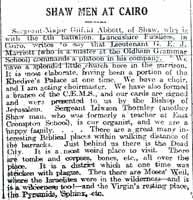
Newspaper
clipping,
(paper and date of publication not identified)
'Shaw Men at Cairo'
(Image link to clipping and transcript)
|
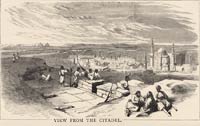
View from the Citadel, at Cairo
Victorian Print
|
The following 8 months were mainly spent alternating between Reserve and the Trenches and in the fighting during the 'Battle of Gully Ravine', in Gallipoli (as part of the 42nd [East Lancashire] Brigade)
You can read more about this on these websites:
42nd and Gallipoli
42nd Division
New Zealand newspaper about Battle of 'Gully Ravine'
Gallipoli Association - Battle of Gully Ravine
On the 27th Dec., 1915, they boarded the S.S. Ermine en route to Mudros.
They remained in Mudros between Jan. 1st and 12th, 1916 then boarded H.M.S. Mars, sailing to Alexandria and arriving on the 16th. From there they travelled by train to Cairo, Mena Camp; 6 days later another train to Tel-el-Kebir; 4 days later another train to Shallufa where they remained for a further 17days (until 17th February)
They stayed in this general area until the 3rd of May, when they were in Suez, where they remained, again staying in the general area until the 22nd June. On the 23rd June they were on their way to Ballybunion [?] where they remained until 29th July. On the 29th Jun they were in Kantara and betwen the 30th July and 4th August, Hill 70, Kantara.
More details (with maps) can be read on this wiki website page:
42nd_(East_Lancashire)_Division
During the 'Battle of Romain', 4th August, the Battalion was on a train to Pelusium, but the next day was in action:
"On the second day of battle, 5 August 1916, the 42nd Division along with the 52nd (Lowland) Division which had fought the previous day from their entrenched position, were ordered to move out to support the Australian Light Horse and New Zealand Mounted Rifles Brigades in a pursuit of the enemy. The 42nd Division was not prepared for the conditions they found in the Sinai desert. They had not been trained to operate in heavy sand in mid summer heat, and with insufficient water, extreme distress and tragedy followed. The mounted troops alone, were unable to stop the enemy making a disciplined withdrawal to water at Katia and to fall back in good order, the following day
The 127th Brigade, 42nd Division eventually reached Katia the next day, 6 August; 800 men had died in the two–day march from Pelusium Station. The 125th Brigade of the 42nd Division and the 155th, and 157th Brigades of the 52nd Division also had many men fall victim to thirst and the blazing sun; the infantry pursuit could not go on."
(quoted from webpage linked above)
[Was this where Captain George E.J. Marriott, suffered the severe sunstroke that hospitalised him?]
The Battalion remained in Egypt until on the 21st February, 1917 on which date they entrained for the journey to Alexandria.
The following day they boarded H.M.T. Megantic, sailing to Marseilles.
They endured a torpedo attack on the 24th February but arrived in port on the 28th February.
The Battalion was en route for the Western Front. George couldn't know it but he had just 4 months left to live.
The dates and place names of the Battalion's movements for the next 4 months give little indication of the fighting that took place:
- From 28th Feb to 1st March. Travelled by train to Pont Remy
- From 2nd to 15th March..They were at Sorel and Wanel.
- 15th March.. By train, Longpré to Corbie; Hamel.
- 15th to 25th March. They were at Hamel
- 25th March to 15th April They were at Eclusier.
- 5th to 9th April They were at Péronne
- 9th April They were at Longavesnes
- 10th to 13th April They were in support, Saulcourt
- 14th April They were in Trenches at Epéhy.
- 15th to 17th April They were at Péronne
- 17th to 22nd April They were at Eclusier.
- 22nd to 29th April They were at Péronne
- 29th April to 1st May They were at Buire
- 1st May They were at Villers Faucon
On May 2nd George celebrated his birthday in the trenches at Lempire.
During the rest of May and June, the Battalion was in and around Ytres and Havrincourt; in and out of trenches and reserve.
- 5th to 8th May They were at Villers Faucon
- 8th to 13th May They were in Support at Epéhy.
- 13th to 18th May They were in Trenches at Little Priel Farm, Epéhy.
- 19th May They were at Villers Faucon
- 20th to 22nd May They were at Equancourt
- 23rd to 25th May They were in Reserve at Gouzeaucourt Wood
- 26th to 27th May They were in Trenches at Villers Plouich
- 28th May to 5th June They were at Ytres
- 5th to 12 June They were in Reserve at Havrincourt Wood
- 13th to 21st June They were in Trenches at Havrincourt.
- 22nd June to 6th July They were at Ytres
- 6th July to 20th August They were at Gomiecourt

The war ended for Captain George Edward Joseph Marriott, age 29 years and 2 months on 6th July, when he was killed in action.
It's unclear, from the Army Movements, whether or not the battalion was in Ytres or Gomiecourt at the time of his death.
His body lies in the Ruyaul Court Military Cemetery.
CWGC
There are several references to George E.J. Marriott in the Supplements of the London Gazette, announcing awards and promotions.
George was commissioned as a 2nd Lieutenant, in early August 1914 (the first rung of the officer ranks). He appears to have been promoted swiftly to 'Temporary Captain' and then, in a series of announcements he is recorded as relinquishing his temporary captaincy (London Gazette 1916-04-25), promoted again as Temporary Captain (London Gazette 1916-05-23). He is promoted to full lieutenant (London Gazette 1916-10-27); became a Temporary Captain again (London Gazette 20 March 1917) and became a full captain (London Gazette 1917-06-19) this being just 2 weeks before he was killed in action.
Note: 'Relinquished' shouldn't be confused with 'demoted'.
The temporary promotions appear to acknowledge leadership qualities to be valued at times when there were not enough officers of rank to fill the gaps in command.
For more info HERE

London Gazette 1916-04-25
|
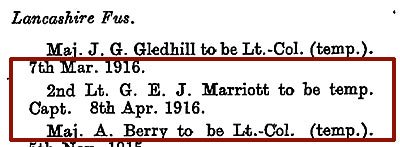
London Gazette 1916-05-23
|

London Gazette 1916-10-27
|
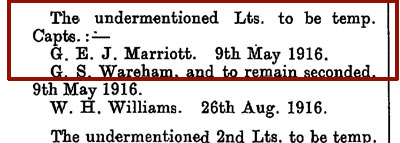
London Gazette 20 March 1917
|
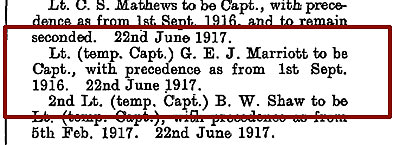
London Gazette 1917-06-19
|
|

